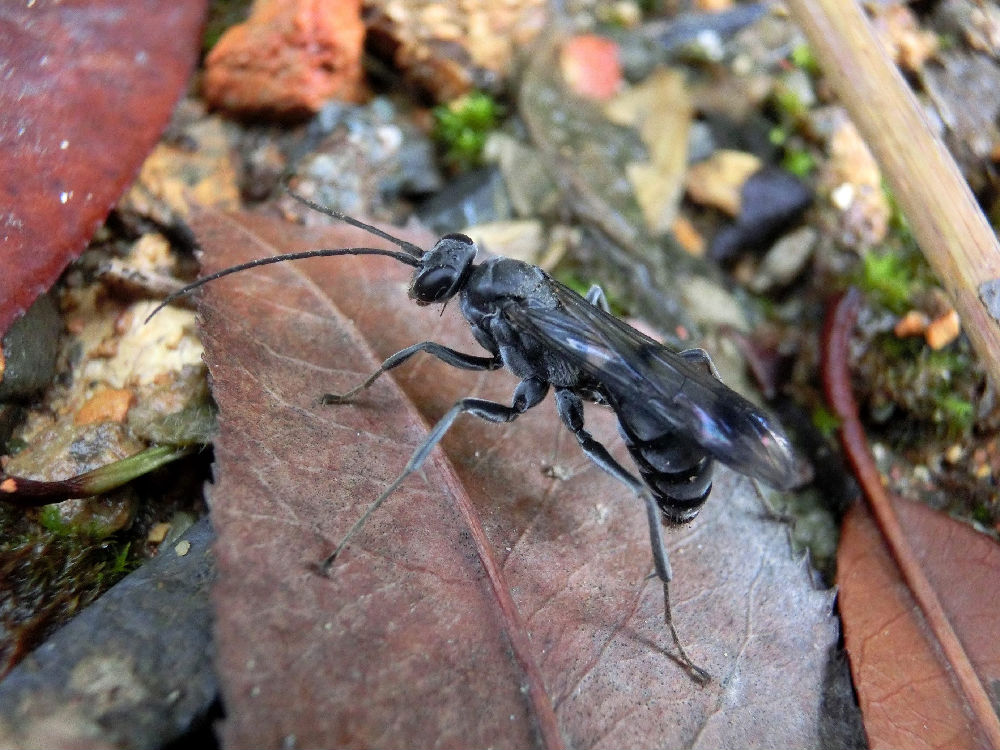博文
Chinese Wall of Ants - Press Release for Journalists
||
Chinese Wall of Ants - New wasp species protects its progeny with dead ants
Embargoed till 2ndJuly 2014, 2 pm EST
媒体相关报导:
1、Google中搜索拉丁文:Deuteragenia ossarium.
2、点击【链接】直接获得结果。
Recently, a new wasp species with a unique nest-construction behavior was discovered in South-East Chinese forests by an international research team from the University of Freiburg, the Museum für Naturkunde Berlin and the Institute of Zoology, Chinese Academy of Sciences in Beijing. The “Antwall Wasp” protects its progeny with a nest-closing plug out of dead ants. A comparable behavior has not yet been reported from the entire animal kingdom.
Scientists of a DFG and NSFC funded research group (www.bef-china.de) belonging to the University of Freiburg, the Museum für NaturkundeBerlin and the Institute of Zoology, Chinese Academy of Sciences in Beijing discovered and described a new species from the family of spider wasps with a intriguing nest-construction behavior in the subtropical forests of South East China. The new species with the scientific name Deuteragenia ossarium closes its nest with a chamber full of dead ants, in order toprotect its progeny from enemies. In spider wasps, every female usually constructs its own nest that consists of several cells. Each chamber is filled with a single spider that has previously been paralyzed by a sting and on which the larva feeds. The same is also true for the newly discovered “Antwall wasp”,which in contrast to all other known spider wasp species does not leave the last cell empty but does fill it up with dead ants.
The scientists published their spectacular discovery in the latest issueof the international journal "PLOS ONE". The investigations of Michael Staab (University of Freiburg) and his colleagues show that the antwall is very effective in protecting the nest. The progeny of the “Antwall wasp” is far less frequently attacked by enemies when compared to other wasps from the same ecosystem. Most likely the unique antwall gives the nest of the wasp a similar smell than the nest of a well-fortified ant species and is thus avoided by natural enemies. The precise defense mechanism is still unclear and subject of recent research.
Dipl. Biol. Michael Staab (Universität Freiburg):
“Our discovery shows in an impressive way what fascinating strategies of nest protection have evolved in the animal kingdom. When I saw such an ant-filled chamber for the first time it reminded me on the ancient Great Wall of China. Just like the Great Wall protected the Chinese empire against attacks from raiding nomad tribes, the antwall protects in the newly-described wasp species the progeny against enemies”
Prof. Dr. Alexandra-Maria Klein (Universität Freiburg):
“Discovering a new species is one of the most exiting experiences of being a scientist. For this new species, it was the very unusual nest construction, which fascinated us immediately. This discovery raises new research questions. Answering them will help us to understand why species diversity is important for the functioning of ecosystems.”
PD Dr. Michael Ohl (Museum für Naturkunde Berlin):
“The enormous global diversity of wasps, bees and ants is full of surprises but what this particular species of spider wasp evolved is more than unusual. From the tens of thousands of nest-constructing wasp species no other species is known to protect its nest in a similar way.”
Prof. Dr. Chao-Dong ZHU (Institute of Zoology, Chinese Academy of Sciences):
“Traps were set up in several places in China to study native beediversity and pollination functioning. Several scientists reported different taxa other than bees built their nests in traps. However, I have never seen antwall strategy. Michael found a fascinating new spider wasp species, which can kill and collect native ant species to protect its nests and children from predators or parasitoids. So, there should be some interactions between spider wasps, spiders, ants, vespids and parasitoids.”
Original publication:
Staab, M., Ohl, M.,Zhu, C.D., Klein, A.M. 2014. A unique nest-protection strategy in a new species of spider wasp. PLOS ONE. doi:10.1371/journal.pone.0101592.
The original publication is freely accessible online under the followinglink http://dx.plos.org/10.1371/journal.pone.0101592.
Photo material:
 Photo 1: Illustration of the uniquenest-protection strategy of the new spider wasp Deuteragenia ossarium.
Photo 1: Illustration of the uniquenest-protection strategy of the new spider wasp Deuteragenia ossarium.
(photo credits: Merten Ehmig)
Photo 2: A female of the "Antwall wasp" in the natural ecosystem in China.
(Photo credits: Merle Noack)
Photo 3: The newly described wasp species is only known from the subtropical evergreen forests of South-east China.
(Photo credits: Michael Staab)
Media:
By Megan Gannon, News Editor | July 02, 2014 02:58pm ET
2. www.upi.com: Spider wasps line their nests with dead ants
The debilitating sting of a spider wasp feels like "dropping a running hair dryer into your bubble bath."
By Brooks Hays | July 2, 2014 at 4:09 PM
3. www.reuters.com/: Stinging rebuke: 'bone-house wasp' builds nest with ant corpses
WASHINGTON
Newly Discovered Wasp Plugs Nest With Cork of Ant Corpses
5. http://www.wired.com/: The Spider-Eating Bone-House Wasp
6. http://www.sciencedaily.com/: New species of spider wasp may use chemical signals from dead ants to protect nest
Date: July 2, 2014
7. http://www.slate.com/: The Wasps of Your Nightmares
By Jane Hu,JULY 2 2014 2:00pm
8. HTTP://WWW.HNGN.COM/: 'Bone-House' Wasp Uses Dead Ants To Protect Its Nest
By Rebekah Marcarelli r.marcarelli@hngn.com | Jul 02, 2014 03:53 PM EDT
9. http://www.businessinsider.com.au/: A Newly Discovered Species Of Wasp Uses The Corpses Of Ants To Protect Its Nest
https://wap.sciencenet.cn/blog-536560-808508.html
上一篇:中国蚁墙 – 蛛蜂新物种用蚂蚁保护后代
下一篇:Michael Staab博士来访学术报告